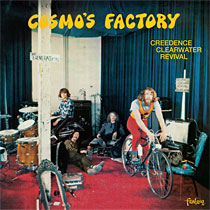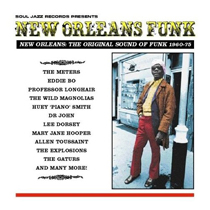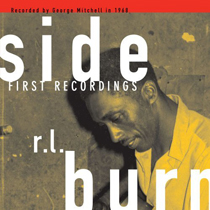Dan Auerbach • Keep It Hid • Nonesuch
- Performance:

- Sound:

Dan Auerbach’s new album is called “Keep It Hid.” It starts out quietly enough, but anyone that is familiar with Auerbach’s work with the Black Keys should know that this wouldn’t last. The man is capable of beautiful melody and quiet interludes, but he can groove too and this is best done loudly. All of his most obvious talents are on full display on “Keep It Hid,” and the results are intoxicating.
You may or may not know that the Black Keys consists of two members. They often sound like six, but Auerbach handles the guitar and vocals while Patrick Carney keeps the drums in order. That’s it for the Keys. That’s all they need. It’s not hard to imagine that a singer-songwriter might feel constrained at times by this arrangement. And Auerbach very well might, but I can’t tell it by listening to his solo record. There are expansions on his familiar palette, but it’s not like he invents a new genre here. And he doesn’t take this opportunity to move away from the general garage-like feel of his previous work with the Keys either. The production is still spectacularly sparse. In fact, I can’t imagine what the man would sound like in a modern studio setting. “Out of place” comes to mind…
Honestly, there are no songs that really jump off the platter above and beyond all the rest on this release to me. I like every one of them, though, and the sides flow together like biscuits and honey. I’m always taken by the emotional depth of Auerbach’s slower songs and he has a couple of winners on this one. “Trouble Weighs A Ton” eases us into the pool and “When The Night Comes” dries us off at the end of side one. Both feature Auerbach’s gravelly vocals with acoustic accompaniment and not much else. The songs between these two would not be out of place on a Tom Waits record. I imagine skeletons playing music in a junkyard would sound a lot like this. Fuzz guitar is prevalent as Auerbach often sings the same scales he plays (“The Prowl”). Again, the songs are more textured than his more famous band’s typically are, but this is no stylistic departure. He still sings through a guitar amp, he still has plenty of clever one-liners, and he still lets loose with his six string when he wants to. The Hill Country Blues influence is still prominent, and he’s still playing songs with titles like “Heartbroken, In Disrepair.” In other words, Black Keys fans can rest easy for now.
Nonesuch did some good things with the vinyl release too. They included a CD of the entire album, and they housed the record in a high-quality rice paper sleeve so there are no paper scuffs staring back at you when you unwrap this one. The artwork is designed to make the record cover look as worn as Auerbach himself, right out of the wrapper. I thought this was a nice touch as Auerbach sounds like a sixty year old as it is. Luckily, he’s not even thirty so his fans have a lot to look forward to. I doubt he’s going to “Keep It Hid” much longer.
New Orleans Funk • The Original Sound of Funk 1960-1975 • Soul Jazz Records
- Performance:

- Sound:

Few, if any, cities in the world can celebrate a musical heritage that can rival New Orleans’. It has its own brand of jazz, its own brand of funk, its own brand of hip-hop, and plenty in between. So many influences converge in that area from so many places by land and by sea that it was bound to produce a rich musical lineage. No one, however, could have planned such an overwhelmingly diverse musical landscape on purpose. It’s a perfect storm of rhythm and syncopation, and the whole effect is aided by the fact that some of the world’s best and most original players have resided there.
Soul Jazz Records is a London based company that specializes in compilations. Reggae and its various offshoots make up much of their catalog, but they’ve made plenty of room for jazz, gospel, Haitian voodoo music, and everything in between. “New Orleans Funk” is a fine collection of deep cuts by some of the city’s most visible practitioners as well as a showcase for some more obscure regional favorites. New Orleans’ first family of funk, the Nevilles, are well represented as one might expect. Aaron’s “Hercules” is an early favorite in the three disc set while Art’s band, the Meters, offer two tracks to digest. “Handclapping Song” is from the super-group’s mostly instrumental era, and “Just Kissed My Baby” is a vocal number with a swampy bassline that makes you reach for your shrimp po’ boy and a Dixie beer. Cyril Neville weighs in with “Tell Me What’s On Your Mind” before the usual suspects take over. Lee Dorsey, Professor Longhair, Dr. John, and Allen Toussaint make their statements with their own tunes, and who knows what, if any, roles they play on the other artists’ songs. New Orleans is a musically incestuous scene, and the artists seem to compliment and contribute to each others’ works rather than competing.
“New Orleans Funk” spans fifteen years worth of music beginning in 1960 so the quality of the recordings varies somewhat, but not wildly. This was an era wherein musicians recorded their parts in the same room at the same time. If a trumpet player was too “hot” in the mix, they might be asked to take a step back rather than waiting for an engineer to tweak the mic placement. This doesn’t make for the cleanest sound by today’s standards, but it makes for a real life music listening experience and I’ll take it any day over our current state of affairs. My copy, specifically, has a lot of surface noise on the second side. It seems like an issue with the record pressing as the noise is prevalent between songs. I’d prefer it if that noise were absent, but it’s kind of a nice analogy for New Orleans as a whole. It’s gloriously imperfect and that adds to the experience if you can relax a little bit and settle into it. A producer once told me that a record that sounds too clean can’t make babies. If that’s the case, then this set of songs alone could have a litter. If you apply that concept to the companion volume that Soul Jazz released recently, you might end up with a population problem. There are worse problems to have, I assure you.
R.L. Burnside • First Recordings • Fat Possum Records / Big Legal Mess
- Performance:

- Sound:

You’ve got to be careful when you tell people that you’re a “blues fan.” The casual blues fan is likely to think that you’re talking about any number of horrible “blues” combos that you see playing in your parents’ favorite neighborhood bar. They have matching outfits & funny names. They thank the crowd between every number and play the same song all night repeatedly at every show. The blues have been watered down and perverted to the point of near extinction, probably moreo than any other genre of popular music that I can think of. (Please, for your own good, don’t get me started on “smooth jazz.”) There are a handful of blues masters – most of them have been dead for years – and an infinite list of substitute teachers that have managed to get over by playing their limited version of what they think is Delta-style blues music.
North Mississippi Hill Country Blues are a different story altogether. Hill Country Blues is trance inducing dance music. It’s music for making love and drinking to, maybe at the same time. Musical cues are often given visually during a live performance of this brand of blues and songs can go on for what seems like a glorious eternity. Fat Possum Records began recording some of the last living proponents of this endangered art in the early 1990’s. This is the label that brought us Junior Kimbrough (who fathered 36 children) and R.L. Burnside (who once shot a man in the back of the head during a card game and claimed self defense). These characters were recorded in juke joints and in their homes, and the electric mud that oozes from your speakers when listening to these records is frightening and beautiful.
Recently, Fat Possum dug deep into the vaults and released some late 1960’s field recordings that George Mitchell made in Burnside’s living room. The feel is far different from that of the more recent records, but the power is as tangible as an anvil, and you’ll suffer in the Mississippi sun no matter what living room you’re listening in. R.L. learned directly from his neighbor, “Mississippi” Fred McDowell. One of his cousins was married to Muddy Waters. The man must have come by his gift honestly. Or maybe that was just the only thing to do in Holly Springs at the time…
It’s hard to comment on the quality of a field recording in today’s language. It’s certainly not audiophile quality. You can hear talking, and walking, and dogs, and screen doors. You can also hear struggle, and redemption, and celebration, and dying. I saw Burnside play many of the same songs found in this collection on multiple occasions and always wanted more. The fact that these early offerings have been released on high quality 180-gram vinyl is a belated gift to his many fans around the world. This man once woke me up off of a hotel room floor in Atlanta at nine o’clock in the morning with a bottle of whiskey that I’d given him the night before. We drank some of it while we watched the “Price Is Right.” If you have even a vague interest in this type of art, I would suggest that you buy this record along with its companion release by Joe Callicot. It’s not your parents’ blues so you can drink whiskey at nine A.M. while you listen to it if you’d like. God knows R.L. did.
Creedence Clearwater Revival • Cosmo’s Factory • Fantasy
- Performance:

- Sound:


It’s hard to imagine that Creedence Clearwater Revival were only together for five years. Their hit singles still saturate classic rock stations today, & it would be easy to assume that those songs were released over the course of a longer period of time. It would be unheard of for a current pop artist to release five albums in less than two years, but that is exactly what CCR did between 1969 & 1970. Their hard work & creative output culminated in “Cosmo’s Factory” which spawned multiple top ten hits and placed the band squarely in the upper echelon of rock royalty at the time. The album also went to number eleven on what would now be Billboard’s Rhythm and Blues Chart. That part, at least, is a little easier to envision given our current artists’ propensities for guest appearances and genre-crossing collaborations.
I discovered CCR’s greatest hits compilation, “Chronicles Volume One,” when I was a freshman in high school. It was one of the first CD’s I owned & I was impressed by its length. There were twenty songs on the compilation and no filler to be found on it anywhere. More than one-third of the songs on “Chronicles” are from “Cosmo’s Factory” which featured eleven numbers on the original release. “Cosmo’s” feels like a live show more than any other studio album I can think of, and the individual songs are even more impressive as parts of the whole rather than as a loose collection of singles.
The band kicks the show off with a high-octane romp through “Ramble Tamble” and a cover of the classic “Before You Accuse Me” which could have been hits for most any other band at the time. But CCR’s catalog was so strong that those songs served as a warm-up before reaching the meat of the matter beginning with the ubiquitous “Travelin’ Band.” Roy Orbison’s “Ooby Dooby” gives the listener a quick respite from the sonic onslaught, and then it’s full-on pedal to the metal until the record’s end. The songs seem sequenced to take the listener through the peaks and valleys of a concert experience before sending us home with the soulful “Long As I Can See The Light.” In between, you have more hits than you would think could ever comfortably fit onto one platter. Songs with names like “Lookin’ Out My Back Door,” and “Who’ll Stop The Rain” amongst others. Really. It’s enough to make your head spin…
The vinyl re-issue is an installment in Universal Music Group’s “Back to Black” vinyl series. The records are 180-gram and the pressing of “Cosmo’s” is clean and quiet with very little surface noise to be found anywhere. The vinyl comes out of the package looking pristine and shiny due in part, I’m sure, to the high-quality rice paper inner sleeve that the record is housed in. Finally, the package includes an MP3 download code for the entire release including bonus tracks! (One of the extras is a version of “Born On The Bayou” from the year before featuring CCR with Booker T. and the MG’s. in the studio.) There are a lot of exciting titles in the “Back to Black” series (including a fair amount of Motown material) and vinyl enthusiasts have a lot to look forward to if all of the other releases are of “Cosmo’s” quality. I expect I’ll have more to report on this subject soon…
Funkadelic • Maggot Brain • Westbound
- Performance:

- Sound:

I must have been about seven years old when I first became aware of “Maggot Brain” by Funkadelic. I was living in Johnson City, Tennessee and my dad and I used to get our haircuts next to Backdoor Records. This was the first indie record store that I’d seen, and it was probably a relatively good one considering the time and location. They sold vinyl and posters and jacket patches and things that I was too young to purchase or make use of. I don’t know what I thought “Maggot Brain” was. I can’t remember if I was seeing an actual album cover or a t-shirt or a poster, but I clearly remember seeing the woman’s screaming head coming out of the ground and being concerned for her well being.
Years later, I was at a concert in Athens, Georgia watching local heroes, Widespread Panic, play one of their legendary Halloween spectaculars when their bassist began talking about Mother Earth being pregnant for the third time and drowning. An epic ten minute (at least) guitar solo followed and I didn’t know which way was up by the time the whole thing was finished. I researched the song to the best of my ability and realized that it was the title track (and guitarist Eddie Hazel’s signature piece) from Funkadelic’s third album. George Clinton, the mastermind behind the band, legendarily told Hazel to play the solo as if his mother had just died, and that’s pretty much the depth of emotion that you’re dealing with when you hear “Maggot Brain.” The rest of the album is extremely diverse stylistically and no less heavy. I’d say it’s a landmark funk album… except that it’s a rock and roll album when you get down to it.
The whole package seems designed to scare the pants off of the common listener. There’s the cover which we’ve already gone over, and there’s the picture of the five band members in the gatefold which shows them gleefully standing in what looks to be a war-ravaged city landscape. There are the liner notes which predict the end of the world. This essay was taken from the Church of the Final Judgement and still makes me a little uneasy as an adult. The music, though, covers gospel, rock, psychedelia, and all manner of general strangeness. There are no misfires on this album, though the last song (“Wars of Armageddon”) is not a personal favorite as it’s lengthy and noisy with no discernible direction. Were it not for that track, I could listen to this album repeatedly from start to finish without ever skipping a song.
4 Men With Beards handled this re-issue which was originally released on the Westbound label, and (just as my copy of “Dusty In Memphis” that I reviewed last month) my record has visible scuffs and surface noise right out of the wrapper. I’ve said it before, but it bears repeating: I don’t see the point of reissuing a classic record on high quality vinyl and housing it in a paper inner sleeve. Still, I’m happy to have added this record to my collection as I made due with the CD for over fifteen years and the sound is so much more agreeable on vinyl. I don’t think Funkadelic will ever be remembered for their cleanliness, and a little surface noise certainly wouldn’t have scared these guys if the album cover hadn’t already.






